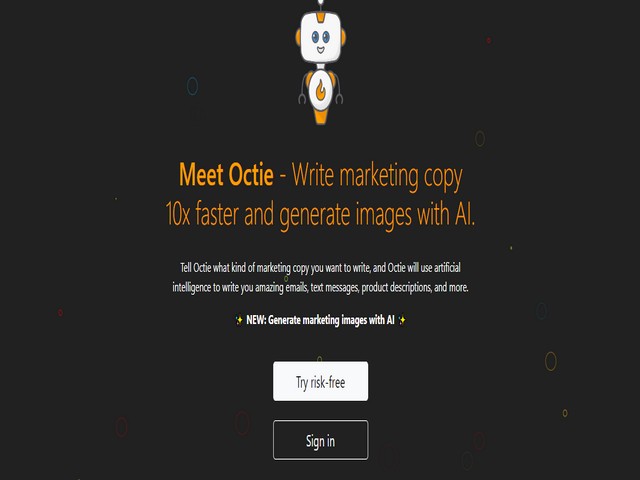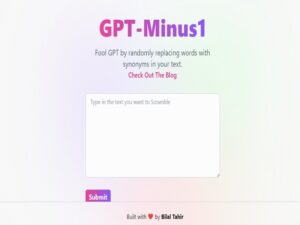Introduction to OCTIE: Revolutionizing Text Understanding
OCTIE is a game changer in the world of text decoding, bringing in a new era of speed and precision in language processing. OCTIE, powered by powerful machine learning and natural language processing algorithms, is at the forefront of AI innovation, providing extraordinary capabilities in textual data analysis and comprehension. Unlike previous approaches, which frequently struggle with the complexities of human language, OCTIE excels in deciphering context, semantics, and subtleties with remarkable precision.
At its heart, it is a flexible tool that can be used in a variety of sectors and applications, including healthcare, finance, marketing, and customer support. Its ability to extract insights, automate activities, and promote informed decision-making has made it a must-have for companies looking to use data-driven knowledge.
it improves operational efficiency by bridging the gap between human language and machine understanding, while also opening up new opportunities in areas such as customized user experiences, predictive analytics, and sentiment analysis.
As we learn more about it’s capabilities and potential effects, it becomes clear that we are seeing a revolution in text understanding that promises to change how we interact with and generate value from textual material in an increasingly digitalized world.
What is OCTIE?
OCTIE is a short form for “OpenAI’s CLIP and T5 for Information Extraction.” OpenAI created a system that integrates two strong AI models: CLIP (Contrastive Language-Image Pretraining) and T5 (Text-To-Text Transfer Transformer) to extract information from textual input.
CLIP is a model shown for understanding both pictures and text, allowing it to link images to written descriptions and vice versa. T5, on the other hand, is a flexible text-to-text transformer model that can handle a wide range of natural language processing tasks, including text summarization, translation, and question answering.
it seeks to excel in understanding and extracting information from textual material in a variety of situations by combining the capabilities of CLIP and T5. This covers things like summarizing articles, answering inquiries, extracting vital information from papers, and more. Overall, it is a cutting-edge method of text application and information extraction, with potential applications in industries such as education, healthcare, finance, customer service, and more.
How Does OCTIE Work?
OCTIE works by combining the capabilities of two powerful AI models, CLIP and T5. Below is an outline of how each component contributes to OCTIE’s functionality:
- CLIP (Contrastive Language Image Pretraining): CLIP is a model that can understand both pictures and words. It learns to connect images with their written descriptions, and vice versa. Using the complete preparation of vast datasets, CLIP develops a deep knowledge of the connections between visual and textual concepts. When paired with it, CLIP allows the model to use visual context in addition to textual information, increasing its capacity to understand and extract meaning from textual input.
- T5 (Text-To-Text Transfer Transformer): T5 is an open text-to-text transformer model that can perform a variety of natural language processing functions. Unlike previous models intended for individual tasks (e.g., translation, summary), T5 uses a unified text-to-text framework in which inputs and outputs are represented as textual sequences.T5 is pre-trained on a variety of tasks using a “text-to-text” technique, in which it learns to map input text to target text for each task. T5’s knowledge and skills may be fine-tuned on certain tasks or domains, allowing it to excel in activities such as summarization, translation, question answering, and other areas.
Key Features and Functionality of OCTIE?
Here are OCTIE’s primary features and functionalities:
1. Text Understanding: OCTIE excels in understanding and extracting meaning from textual material by utilizing powerful machine learning and natural language processing techniques.
2. Integration of CLIP and T5: it integrates the capabilities of two powerful AI models, CLIP (Contrastive Language-Image Pretraining) and T5 (Text-To-Text Transfer Transformer), to produce a single framework for understanding text and information extraction.
3. Multimodal Understanding: By using CLIP, which understands both pictures and text, OCTIE may include visual context with textual information, improving its understanding skills.
4. Versatility: it applies applications to a variety of natural language processing programs, including summarization, translation, question answering, sentiment analysis, and others.
5. High Accuracy: it delivers high accuracy in text interpretation tasks due to the integration of cutting-edge AI models and substantial pretraining on big datasets. 6. Efficiency: it can swiftly and efficiently handle vast amounts of textual data, automating processes that would otherwise take time and resources to complete manually. 7. Scalability: it’s capabilities may be scaled to manage rising workload needs and analyze huge datasets, making it ideal for use in sectors with high data volumes. 8. Automation: it automates monotonous operations like document analysis, content summarizing, and customer assistance, freeing up human resources for more strategic and creative projects.
9. Adaptability: By finetuning and adapting to specific tasks or domains, OCTIE may continually enhance its performance and respond to new challenges and settings.
10. DataDriven Insights: it gives significant insights into textual data, allowing organizations to make datadriven choices, extract actionable knowledge, and achieve a competitive advantage. 11. Interpretability: While complicated, efforts may be taken to improve the interpretability of OCTIE outputs, allowing users to understand how choices are made while also encouraging trust and transparency. 12. Ethical Considerations: it tackles ethical concerns such as data protection, fairness, openness, and responsibility, encouraging the appropriate and ethical use of AI in text interpretation tasks.
Overall, OCTIE’s core characteristics and functions make it an effective tool for a wide range of industries, including healthcare, finance, education, customer service, and others, where accurate and efficient text interpretation is critical to success.
Benefits of Using OCTIE
Here are some of the benefits of using OCTIE:
- Increased Efficiency: it is automates tasks related to text understanding and information extraction, saving time and resources compared to manual methods.
- Enhanced Accuracy: With its advanced AI models and extensive training, OCTIE achieves high accuracy in understanding and extracting meaning from textual data.
- Versatility: it is versatile and adaptable to a wide range of natural language processing tasks, including summarization, translation, question answering, sentiment analysis, and more.
- Scalability: it’s capabilities can scale to handle large volumes of textual data, making it suitable for applications in industries with high data volumes and processing requirements.
- Data-Driven Insights: it’sprovides valuable insights into textual data, enabling organizations to make data-driven decisions, derive actionable intelligence, and gain competitive advantages.
- Automation of Repetitive Tasks: it is automates repetitive tasks such as document analysis, content summarization, and customer support, freeing up human resources for more strategic and creative endeavors.
- Improved Decision Making: By extracting relevant information from textual data, OCTIE helps organizations make informed decisions faster and more accurately.
- Adaptability: it can be fine-tuned and adapted to specific tasks or domains, allowing organizations to customize its capabilities to suit their unique needs and challenges.
- Enhanced User Experience: it can improve user experience by providing personalized recommendations, automated responses, and tailored content based on individual preferences and behaviors.
- Cost Savings: By streamlining processes and reducing manual effort, OCTIE helps organizations save costs associated with labor, time, and resources.
Overall, the benefits of using it include increased efficiency, enhanced accuracy, versatility, scalability, data-driven insights, automation of repetitive tasks, improved decision-making, adaptability, enhanced user experience, and cost savings. These advantages make OCTIE a valuable tool for various applications in industries such as healthcare, finance, education, customer service, and beyond.
Challenges and Future Directions
Here are some challenges and potential future directions for OCTIE:
Challenges:
Interpretable Outputs: Improving the interpretability of OCTIE’s outputs is a challenge, as understanding how decisions are made is crucial for user trust and transparency.
Bias Mitigation: Addressing biases inherent in training data and models is essential to ensure fair and unbiased outcomes in text understanding tasks.
Ethical Considerations: it raises ethical considerations such as data privacy, fairness, transparency, and accountability, which must be carefully addressed to ensure responsible and ethical use.
Data Quality: The performance of OCTIE is heavily reliant on the quality and diversity of the training data, and inaccuracies or biases in the data can impact the reliability of its outputs.
Domain Adaptation: Fine-tuning OCTIE for specific tasks or domains may require extensive labeled data and expertise, posing challenges for organizations lacking in-house resources.
Scalability: As the volume and complexity of textual data continue to grow, ensuring OCTIE’s scalability to handle increased workload demands remains a challenge.
Future Directions:
Interpretability Enhancements: Future research could focus on developing techniques to increase the interpretability of OCTIE’s outputs, allowing users to understand how decisions are made and fostering trust and transparency.
Bias Detection and Mitigation: Continued efforts are needed to develop methods for detecting and mitigating biases in OCTIE’s outputs, ensuring fair and unbiased outcomes in text understanding tasks.
Ethical Frameworks and Guidelines: Establishing ethical frameworks and guidelines for the responsible and ethical use of OCTIE can help address ethical considerations and promote best practices in AI governance.
Data Augmentation and Diversity: Increasing the diversity and representativeness of training data used for OCTIE can help improve its performance and generalization capabilities across different domains and languages.
Domain Adaptation Techniques: Research into more efficient domain adaptation techniques for OCTIE could help reduce the need for extensive labeled data and expertise, making it more accessible to a wider range of users.
Integration with Knowledge Graphs: Integrating OCTIE with knowledge graphs and external knowledge sources could enhance its understanding of context and improve the quality of its outputs in complex tasks.
Explainable AI: Developing explainable AI techniques for OCTIE could help users understand and trust its outputs, leading to better user acceptance and adoption in various applications.
Overall, addressing challenges such as interpretability, bias mitigation, ethical considerations, data quality, scalability, and domain adaptation, while exploring future directions such as interpretability enhancements, bias detection and mitigation, ethical frameworks, data augmentation, domain adaptation techniques, integration with knowledge graphs, and explainable AI, can help unlock the full potential of OCTIE and ensure its responsible and effective use in text understanding tasks.
Conclusion
n conclusion, OCTIE represents a powerful advancement in the field of text understanding and information extraction, offering a wide range of capabilities and applications across various industries and domains. Through its integration of advanced AI models like CLIP and T5, OCTIE excels in understanding and extracting meaning from textual data with high accuracy and efficiency.
While OCTIE offers numerous benefits, including increased efficiency, enhanced accuracy, versatility, and scalability, it also poses challenges such as interpretability, bias mitigation, ethical considerations, data quality, scalability, and domain adaptation.
Addressing these challenges and exploring future directions such as interpretability enhancements, bias detection and mitigation, ethical frameworks, data augmentation, domain adaptation techniques, integration with knowledge graphs, and explainable AI can help unlock the full potential of OCTIE and ensure its responsible and effective use in text understanding tasks.
Overall, OCTIE holds immense promise for revolutionizing how we interact with and derive insights from textual data in an increasingly digital and data-driven world. By continuing to innovate, address challenges, and advance responsible AI practices, OCTIE can contribute to advancements in various fields and empower organizations to make informed decisions, derive actionable intelligence, and drive innovation through text understanding and information extraction.



